
Visualizing and Quantifying Human Capital to Achieve SOMPO’s Purpose
February 17, 2025
C-2024-001-4WE
1.Introduction
In recent years, concepts such as purpose management and human capital management have gained attention as central themes to describe corporate management. The last decade, especially, has seen a rising awareness of global social and environmental issues. This, together with the workstyle reforms sparked by the COVID-19 pandemic, has led to substantial changes in our perceptions of the purpose (raison d’être) of companies and the value of their employees.
In line with this trend, many companies, regardless of nationality and industry, are endeavoring to engage in strategies and business activities that identify purpose and human capital as the focus of management. At the same time, other companies, including Sompo Holdings, are also experiencing how difficult it is to implement these initiatives.
In this paper, we present a general overview of trends relating to purpose management and human capital management, as well as the current situation and related issues. We then proceed to consider the recent conditions and future of purpose management and human capital management through initiatives actually implemented by the Sompo Group to achieve an organization-wide understanding of its purpose and enhance, visualize, and quantify human capital.
2.Current Situation and Issues Relating to Purpose Management and Human Capital Management
The rise of interest in purpose management and human capital management has occurred in the context of a broader trend toward sustainability. Historically speaking, the current interest in sustainability arose from the ESG movement motivated by the Principles for Responsible Investment (PRI) established by the United Nations in 2006. It was boosted by the rise of CSV, proposed during the 2010s as a new management approach to help companies simultaneously pursue economic and social value, as well as the adoption of the 17 Sustainable Development Goals (SDGs) for 2030 established by the United Nations in 2015.
It was in this context that companies began to question how they could incorporate sustainability into their own strategies to achieve sustainable growth. The concept of purpose management came to prominence around 2020 as a growing global trend that breaks with conventional, shareholder-focused capitalism. This trend can be observed in initiatives such as the statement issued in 2019 by Business Roundtable, a group of senior managers in the United States, proposing a change to stakeholder-focused capitalism, as well as through the introduction of mandatory and more rigorous disclosure requirements for information on human capital by the United States Securities and Exchange Commission (SEC) in 2020 and the European Union (EU) in 2021.
In Japan, too, recommendations such as those of the “ITO Report for Human Capital Management” by Kunio Ito (METI 2020; METI 2022a; METI 2022c) and Takashi Nawa’s “Purposism” (Nawa 2021) are leading examples of the concurrent rise in the need for purpose management and the increase in focus on the attributes of human capital needed to increase organizational capabilities to implement purpose management.
The trend toward corporate purpose management has grown on various fronts, such as the publication of “PAS 808 - Purpose-driven organizations — Worldviews, principles and behaviours for delivering sustainability — Guide,” the world’s first international standard for certifying purpose-driven organizations, by the British Standards Institution (BSI) in 2022.
Some time has now passed, with an increasing number of companies joining this trend to engage in purpose management and human resource management. At the same time, however, voices have emerged raising issues and sounding an alarm.
For example, in the attitude survey of consumers and business leaders overseas and in the global attitude survey of consumers and business leaders conducted by BSI in 2022, 40% of business leaders in Japan responded that their companies had a clear, written purpose, significantly lower than in other countries (93% in China, 86% in India, 72% in the United States, and 63% in the United Kingdom), indicating Japan’s backwardness in this respect (BSI Japan 2023).
A report issued by the Ministry of Economy, Trade and Industry (METI) in May 2022 points out that while Japanese companies are progressively clarifying their corporate philosophies, purposes, and business strategies, they are relatively behind in their progress on linking business strategies to human capital strategies (METI 2022b). The specialist Yuji Kobayashi reveals the issues associated with implementing purpose management in his 2023 article for JBpress.
He writes that despite companies’ efforts to set forth a purpose and ensure its penetration throughout the organization, it is not easy for them to get employees to play along. Often, employees disregard corporate philosophies and purposes as nothing more than superficial statements by senior management. It is not unusual to find a mood of disinterested apathy towards these initiatives within Japanese companies (JBpress 2023).
As purpose management and human capital management are long-term initiatives, it is not possible to conclude their effectiveness from the results of the past few years alone. At the same time, it is no easy matter for companies to seek out the path to their implementation independently. In this paper, therefore, we summarize the Sompo Group’s initiatives relating to purpose and human capital, presenting the insights we have gained thus far, in the hope that it will assist others to likewise consider the ways that they can create value by enhancing human capital to achieve each corporate purpose.
3.The Sompo Group’s Initiatives
We will start with a brief overview of the Sompo Group. The Group is engaged in providing products and services in Japan and overseas, mainly in the areas of domestic property and casualty (P&C) insurance, overseas insurance and reinsurance, and wellbeing (domestic life insurance and nursing care). The Group’s Purpose states “For a future of health, wellbeing, and financial protection,” and we engage in business activities aimed at realizing this Purpose.
Altogether, 74,904 officers and employees work in the Group (as of March 31, 2024), handling intangible products and services on a daily basis to provide value to our customers. Each of our employees is a source of value creation for the Group, and we have consistently engaged in enhancing human capital as the Group’s highest priority management issue.
In FY2023, however, a series of issues came to light in the Domestic P&C Insurance Business, including fraudulent automobile insurance claims by used car dealerships that act as our insurance agencies and the adjustment of premiums for corporate insurance, leading to criticism of a corporate culture that overemphasizes top-line revenue and market share.
Since FY2021, we have continued to engage in instilling the Group’s Purpose and reforming work styles as one of the pillars of our Mid-Term Management Plan. However, with these revelations, it became clear that the Purpose had not penetrated our organization quickly enough and had not taken root in the foundation of the Group’s businesses.
By using examples of specific measures and presenting actual data on how the Sompo Group, faced with these difficulties in implementing purpose management and human capital management, went about creating an overall design, the initiatives it implemented, and the changes and issues that arose from these initiatives, we hope to provide some helpful insight for those seeking a path forward to the implementation of their own companies’ purpose management and human capital management.
4.Overall Design of Initiatives
(1) The Way of Thinking that Underpins Our Approach
We established our Purpose at the Sompo Group in 2021. Together with the management strategy of continually transforming to achieve this purpose, we envisaged a value creation story focused on the overlap between corporate and individual purposes, where our people and organization would drive the provision of value through our business activities (Fig. 1).
Figure 1: Overlap Between Corporate Purpose and Individual Purpose
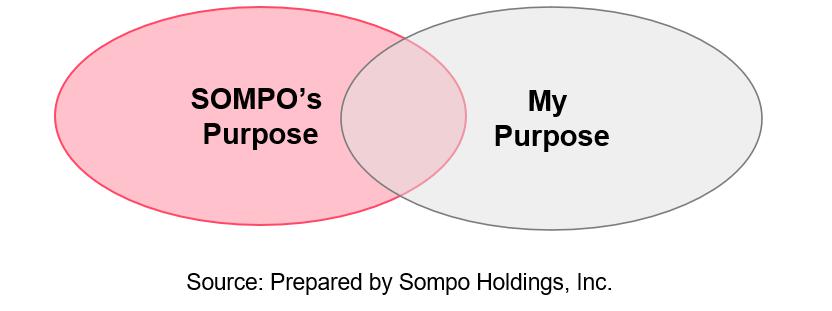
The qualitative transformation of each employee, in addition to business transformation, is necessary to achieve Sompo’s vision. To this end, we need them to make a paradigm shift in value perceptions from thinking of “positioning one’s life as a part of the company” to thinking of “positioning the company as a part of one’s life.” For all employees across the Group to have their own ideals and aspirations, to be motivated by these, and to work with a feeling of their connection with the organization-wide purpose embodies the meaning of our value creation story.
At the Sompo Group, we refer to each individual’s ideals and aspirations as “My Purpose.” Since around 2021, we have used this as our starting point to engage in instilling the Group’s Purpose throughout the organization and enhancing human capital. “My Purpose” refers to “purpose of life” and the “meaning of work” that each individual already carries around within themselves — the kind of person they are, how they define happiness, and what they want to achieve in life. At the Sompo Group, we encourage each individual to consider themselves from the three perspectives of WANT (intrinsic motivation), MUST (social responsibility), and CAN (ability given to us by fate). The factors common to all three perspectives are what stimulates them: their “aspirations.” Putting these into words provides a guide for each individual’s life and career, as well as motivating their efforts (Fig. 2).
Figure 2: What is My Purpose?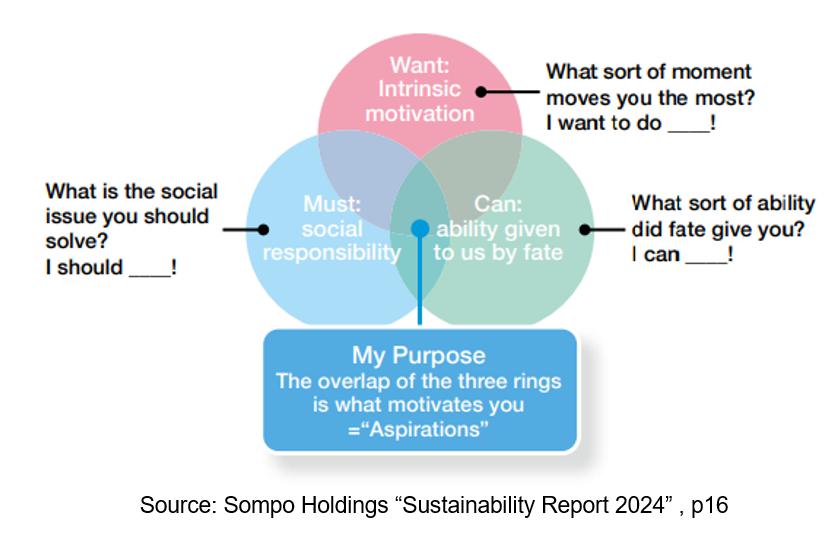
That being said, even if we create opportunities for transformation based on My Purpose and implement various related measures and system reforms, purpose management and the implementation of human capital enhancements are still not that simple. It is essential to make continuing efforts premised on a medium- to long-term timeframe, coordinating these efforts with our business activities and linking them to sustainable value creation. From the outset, therefore, we engaged in overall design with the following points in mind.
1) We created a detailed story, as well as a practical mechanism and framework for the enhancement of human capital and the creation of actual value through business, with My Purpose as the starting point.
2) While these initiatives will lead to future financial value over a medium- to long-term timeframe, their short-term financial benefits are difficult to perceive. We therefore determined to enable the visualization of pathways to future financial value and quantify our progress from the outset.
3) We decided to reveal the mechanisms for change and follow a PDCA cycle, considering and measuring the effects of initiatives to facilitate this change, especially for the processes leading from My Purpose to greater employee engagement.
4) The dynamics of innovation are essential if we are to continue to generate outcomes in terms of motivating human capital from a medium- and long-term perspective. We aimed to create mechanisms and organizations that enable employees to take on more challenges and accumulate advanced knowledge, as well as facilitate internal and external knowledge-sharing, which are key to achieving this goal.
The Impact Path shown in Fig. 3 is a representation of the design of the story, described above, aimed at realizing SOMPO’s Purpose. The Impact Path represents the entire path beginning from the pursuit of My Purpose and our action relating to the promotion of diverse work styles, through the creation of changes linked to enhancing engagement within the organization (“inner changes”) and changes to promote more challenge-taking (“emerged changes”) to the creation of financial value (outcomes) from short-, medium-, and long-term perspectives and, thus, to the achievement of SOMPO’s Purpose.
Figure 3: The Impact Path of Human Capital
As shown in Fig. 3, we hope to use My Purpose as the starting point to promote the enhancement of human capital, reveal the mechanism that ultimately coordinates it with business activities, linking it to value creation and the achievement of SOMPO’s Purpose, and track our progress as we pursue this path. Of course, instilling SOMPO’s Purpose throughout the Group and enhancing human capital are not themselves our ultimate goals; rather, they are ways to create value for our stakeholders through our business. Our efforts to visualize and quantify human capital using the Impact Path are intended to propose and verify the links between each separate measure, indicating theories that will form the basis for increasing reproducibility to create value along the path leading to our business activities, thereby helping to achieve these aims.
(2) Initiatives for Further Systemization: Towards Visualization and Quantification
This Impact Path is based on the actual conditions on the front lines of our business. It was developed through the implementation of a process conforming to the SECI Model[1] for generating innovation. In other words, we have hypothesized the value that is created in line with the story behind the Impact Path, implemented measures, gathered data on the front line, and verified our hypothesis through the analysis of this data, progressing step by step to indicate how it is linked to financial results. Why did we at SOMPO engage in systematizing the process like this? When we first launched these initiatives, we wanted a model of value creation beginning with individual employees, but as no such model was available to us, we had to proceed through trial and error.
More specifically, we thoroughly analyzed the front line of our business and pinned down the mechanism for value creation based on the idea that the solution, or at least a hint of the solution, would be found on the front line where value was actually being created through our business. We gathered tacit knowledge by using various opportunities to conduct hearings and interviews with people at around 150 front-line locations engaged in purpose-driven operations, where greater organizational strength was enabling them to visualize new challenges. We proceeded to transform this tacit knowledge into explicit knowledge through analysis and systematized the mechanism of organizational change that led to increased employee engagement. We also borrowed expertise from outside the Group to give some shape to the specific changes observed after employees visualized these challenges, which differed significantly by business factors such as industry and occupation. Figure 4 presents a detailed illustration of the Impact Path created through the process described above.
Figure 4: Impact Path (Detailed Illustration)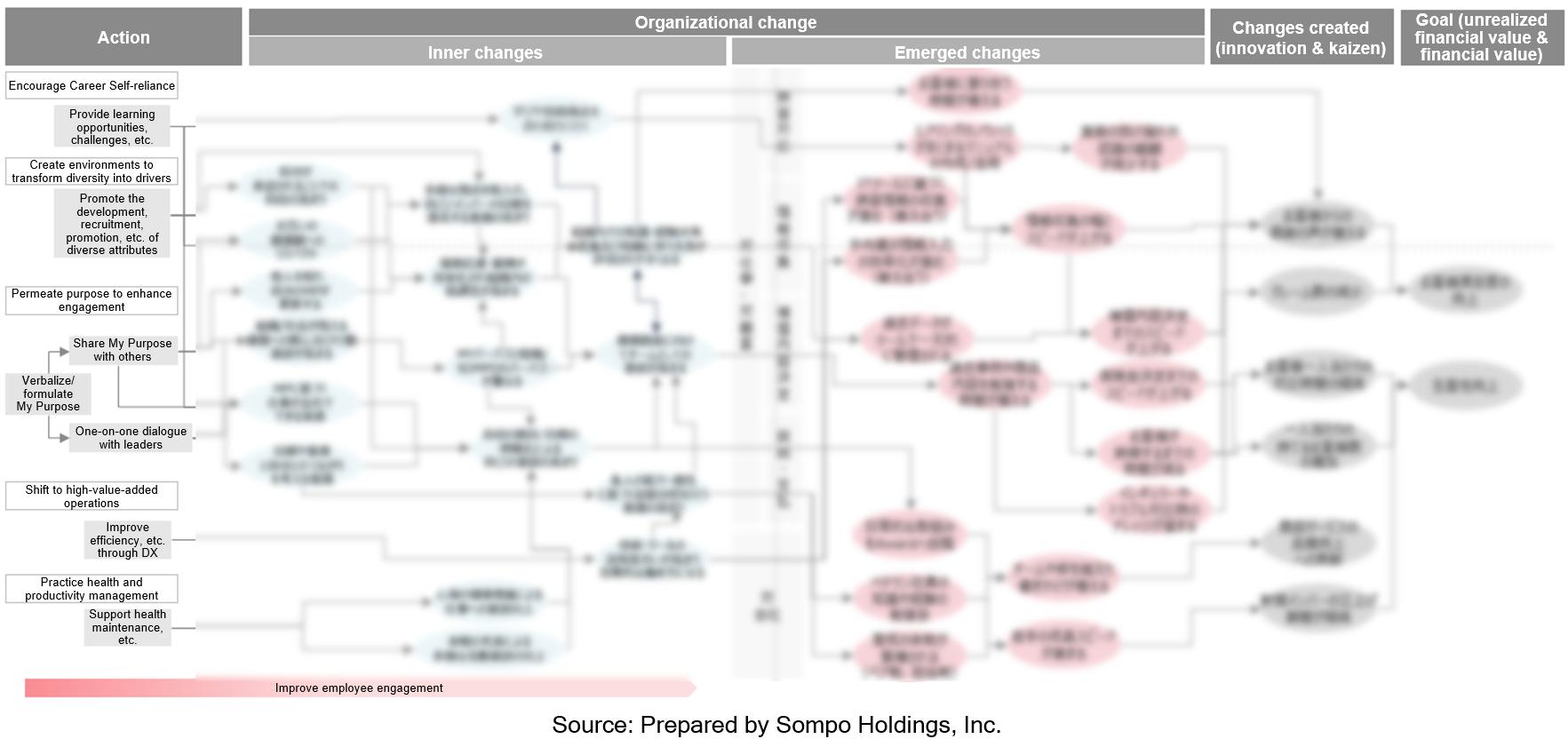
Through this initiative, we determined the three elements of the inner changes linked to enhanced employee engagement: “individual changes,” “relationship changes,” and “organizational changes.” We discovered the mechanism whereby these elements connect to increase engagement and boost the power of individuals and organizations.
We have moved on to implementing Group-wide initiatives based on these advanced case studies, developing measures to encourage change in line with each item, and collecting data to verify the results of these measures, including quantitative verification, to enable these three types of change and the Impact Path process to be reproduced on the business front line. A list of the measures we are implementing with this aim is presented in Fig. 5 (see Fig. 10 at the end of the paper for the measures apart from inner changes).
Figure 5: Measures to Promote Inner Changes (Extract)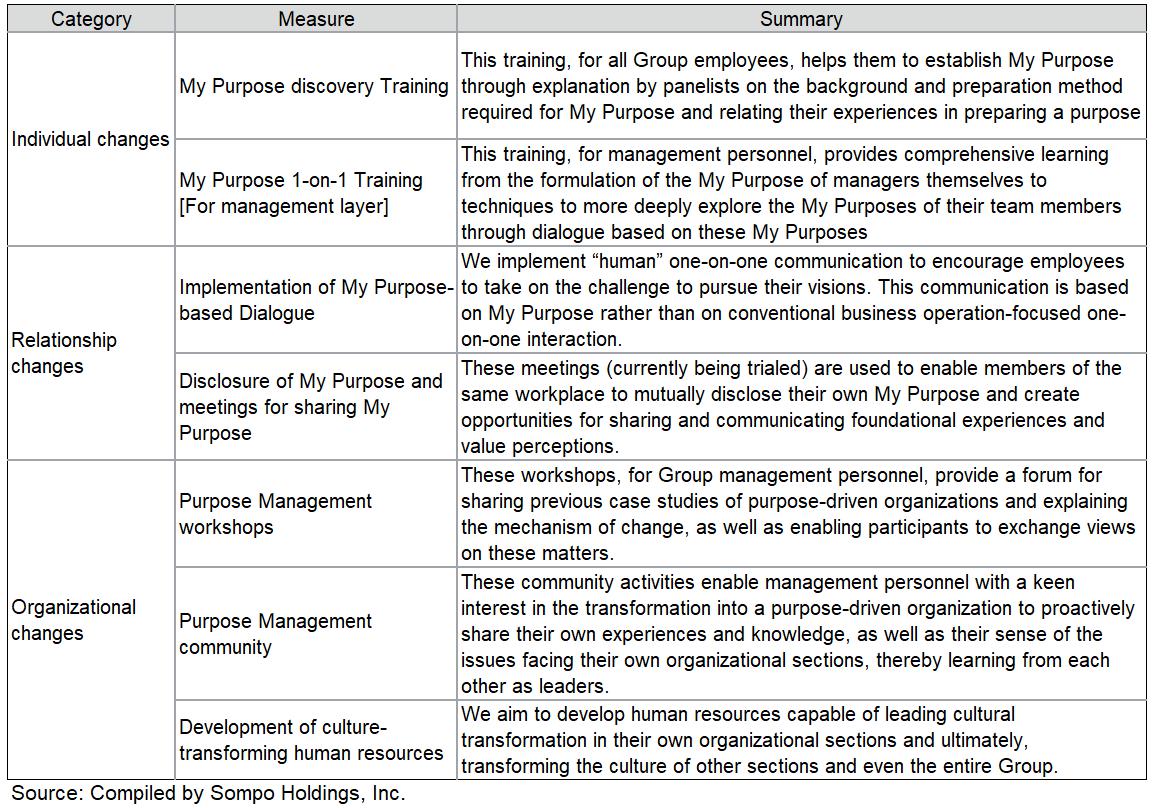
5.Actual Initiatives to Promote Inner Changes
In this section, we discuss the actual changes observed and quantitative data for some leading initiatives focused on the three elements of inner changes: (1) Individual changes, (2) Relationship changes, and (3) Organizational changes.
(1) Individual changes
Individual changes are the changes that occur within each individual through introspection and dialogue, including aspects such as the formulation and deep exploration of My Purpose, as described above. Through this process, individuals reveal what is important to themselves and qualities such as their own unique style, and sense of happiness and achievement, which they already hold within themselves. The experience of these qualities as they work provides a foundation for greater employee engagement, taking on challenges, and creating innovations based on intrinsic motivation.
We implement Group-wide initiatives such as “My Purpose discovery Training” for all employees, to help them formulate My Purpose and “My Purpose 1-on-1 Training” for leaders within the organization, where they learn how to explore the individual My Purpose of their team members more deeply, as well as dialogue skills based on this. We ensure that all employees in the Group prepare their own My Purpose and use it as a basis for dialogue.
These processes to encourage deep introspection by all employees are aimed at engendering a change within individuals similar to the growth from the dependence stage (the stage of habit) to the self-authoring stage in adult development theory[2]. When employees grow as far as the self-authoring stage, they are able to clearly maintain their own values and decision-making criteria, resulting in more advocation of their own views, without being sidetracked by those around them, and more autonomous action and learning in line with their own aims (Kato 2016, p.252).
With continuing analysis of data from engagement surveys of employees in the Group, we have obtained quantitative confirmation that these individual changes can contribute to greater engagement[3]. Figure 6 presents the results of the analysis of responses to the engagement survey implemented by Sompo Japan Insurance Inc. in July 2024, by section and branch (n=943). These results indicate that engagement tends to be higher among sections and branches where members more clearly articulate their My Purpose and are more conscious of overlaps between their own My Purpose and SOMPO’s Purpose. We can assume from this that initiatives relating to My Purpose tend to increase employees’ motivation toward daily business operations.
Figure 6: Data verification “Individual changes”
(2) Relationship changes
Relationship changes refer to the changes in the relationships between employees that occur as a result of the disclosure of My Purpose by managers and workplace members and the dialogue based on this, focused on My Purpose. There is mutual interplay between “individual changes” and “relationship changes.” Through communication with others, employees gain a broad range of perspectives and by calling each other’s attention to various matters, they mutually accelerate the process of change. This communication forms the foundation upon which new value is created.
We promote one-on-one dialogue based on My Purpose between supervisors and subordinates in each organizational section, as well as the disclosure of, and forums for sharing, My Purpose with other members in the same workplace. We also present examples of sections pursuing these initiatives and share best practices.
In this way, dialogue and information sharing based on My Purpose is aimed at deepening employees’ mutual understanding and cultivating relationships of mutual respect for diverse value perceptions and views. By interacting with others within their own section, employees find that they stimulate each other and achieve mutual growth, which motivates them to actively communicate and share their value perceptions and views, while also increasing proactive communication and decision-making that demonstrate respect for others.
Utilizing an analysis of correlation, we have quantitatively confirmed that encouraging employees to engage in dialogue based on My Purpose and accept each other’s value perceptions through initiatives such as these contribute to increasing diversity and enhancing employee engagement. For example, sections where employees engage in more dialogue based on My Purpose and accept each other’s value perceptions tend to have higher employee engagement (Fig. 7; the correlation coefficients are 0.64 and 0.84, respectively, with an analysis for n=943, as in the case of individual changes).
Figure 7: Data verification “Relationship changes”
(3) Organizational changes
Organizational changes refer to changes that bring about organization-wide revitalization, such as an increase in the motivation to create value within teams and an increase in the sharing of individual insight (knowledge). They occur through “individual changes” and “relationship changes.” Teams undergoing organizational changes simultaneously experience a rise in employee engagement and the development of an atmosphere where challenges are encouraged, and the associated failures are tolerated. As a result, they create a desire to take on challenges and encourage innovation.
These three types of change — “individual,” “relationship,” and “organizational” — do not necessarily occur in that specific order. Rather, we believe that a purpose-driven team is one in which My Purpose provides a starting point for employee interaction, thereby leading to a cycle of continuing organizational growth.
In terms of Group-wide initiatives, we are implementing various measures to increase the number of these purpose-driven teams and encourage management transformation, which is key to their achievement. For example, in our “Purpose Management workshops,” we regularly share case studies of organizations that have implemented performance management and hold discussions between management employees. These workshops have led some managers with a keen interest in organizational transformation to spontaneously form a “Purpose Management community” , connecting with each other across organizational divisions to share their own experiences and knowledge as they strive to practice performance management. Through these initiatives, we encourage managers themselves to transform so that they can grow into human resources capable of leading Group-wide transformation. At the same time, it is vital that these initiatives are underpinned by our personnel and evaluation systems, and we are enhancing environments to develop human resources to lead transformation.
Even as a series of issues emerged, we were able to confirm, quantitatively, that this My Purpose-based management is increasing our organizational resilience[4]. Specifically, sections and branches engaging in dialogue based on My Purpose tended to have maintained their employee engagement compared to FY2023. We were also able to infer that sections and branches with high employee engagement tended to suffer smaller declines in employee desire to take challenges (Fig. 8). We believe that this is evidence of the link between purpose-driven management and the creation of organizations that can proactively take on the challenge to change, even under adverse conditions (n=943, as in the case of the analysis of individual changes).
Figure 8: Verification of the effects of My Purpose-based management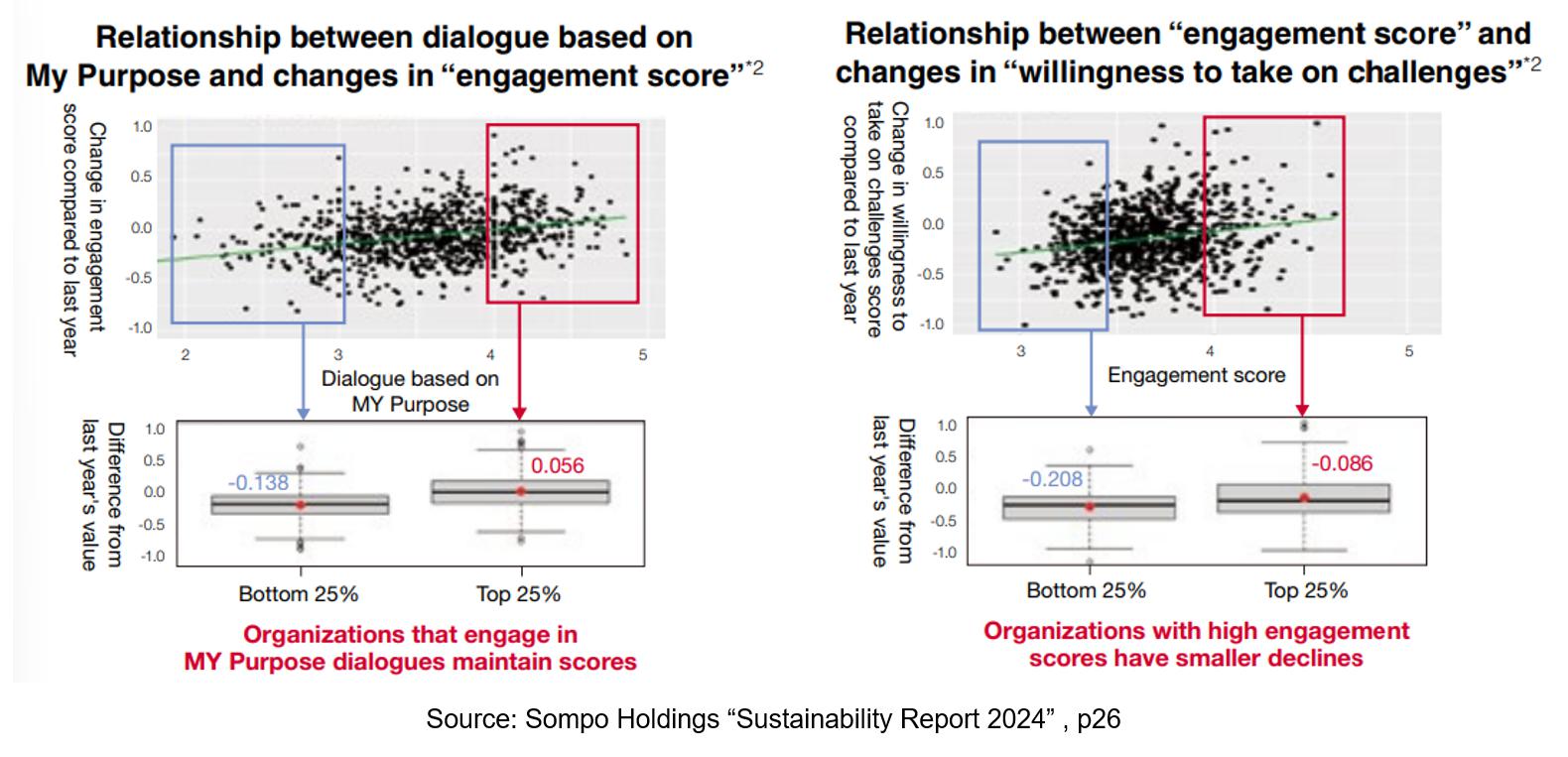
(4) Evidence from other data analyses
As a supplement, we have summarized our findings from quantitative analyses, apart from those described above, into the four key points outlined below (Fig. 9; n=943, as in the case of the analysis of individual changes).
Figure 9: Other Data Analyses[5]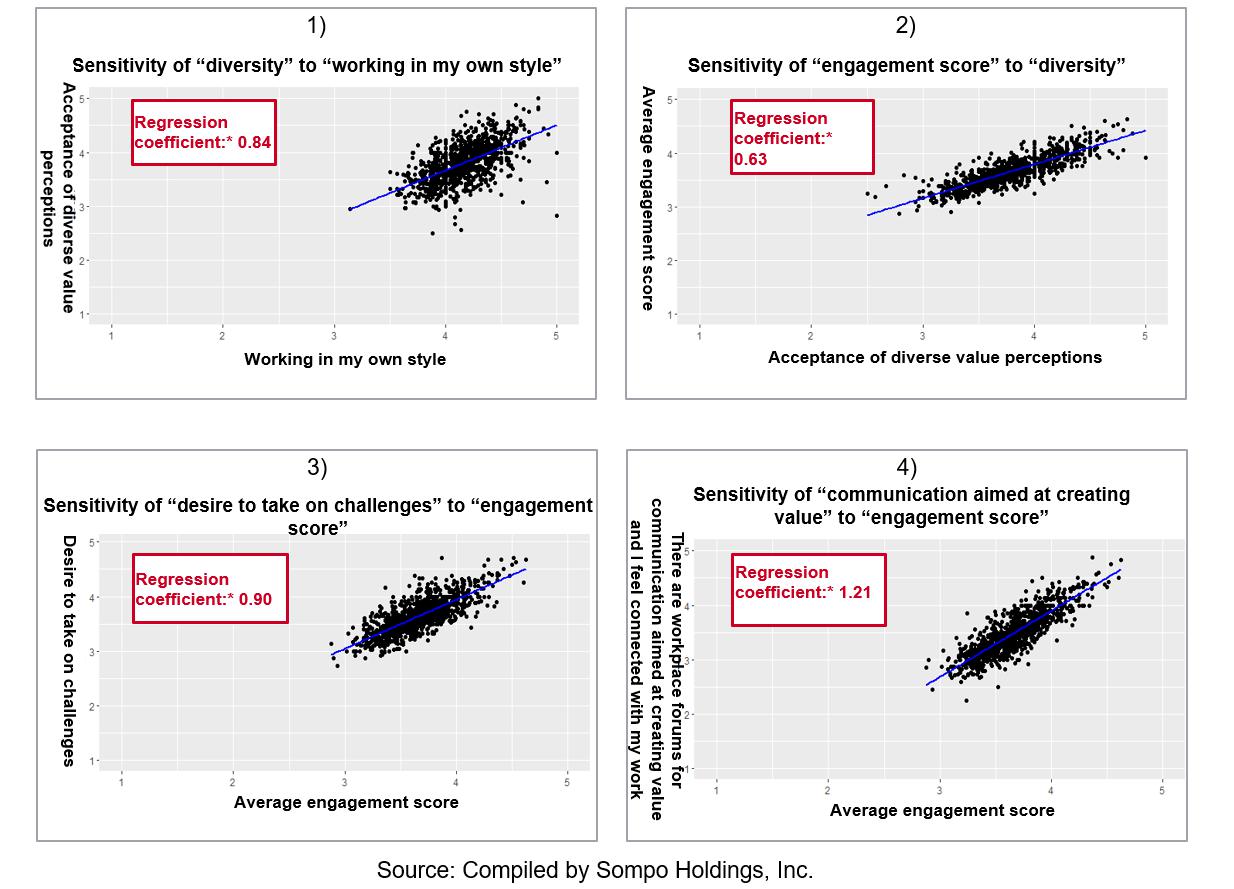
1) For each unit increase in employees feeling that they “want to work in my own style,” their feeling of the “acceptance of diverse value perceptions” increased by an estimated 0.84 points.
2) For each unit increase in employees’ feeling of the “acceptance of diverse value perceptions,” their “engagement score” increased by an estimated 0.63 points.
3) For each unit increase in employees’ “engagement score,” their “desire to take challenges” increased by an estimated 0.90 points.
4) For each unit increase in employees’ “engagement score,” their feeling of a “workplace focused on value creation, including communication about the internal and external environments, and connections between my work and the corporate mission” increased by an estimated 1.21 points.
As we have shown, these analyses, supported by data, confirm changes that are largely in line with the hypothesis we established at the initial stage of the overall design. By connecting the story behind the Impact Path through correlation and regression analyses in this way, we believe we can discover relationships of cause and effect. We are aggregating specific initiatives, case studies of measurable change within organizations, and the results of statistical and other analyses from the front line of business, to communicate to those inside the Group and externally.
6.Conclusion (Prerequisites for Connecting Human Capital Initiatives to the Achievement of Purpose)
By using My Purpose as a starting point to enhance human capital, the Sompo Group has worked toward achieving SOMPO’s Purpose. As described above, we have confirmed that these initiatives have given rise to three types of changes leading to an increase in employee engagement. In some cases, they have also resulted in the targeted changes. Our continued efforts over the past few years, however, have proven insufficient. In fact, a series of problems have come to light since FY2023, exposing these efforts as still a work in progress, and we have strongly felt how difficult it is to instill this approach as an organizational culture and connect it to the actual creation of value. Going forward, it will be essential to take these initiatives aimed at instilling purpose and enhancing human capital and refine them to enable the Sompo Group to make a genuine fresh start, rather than simply an extension of the present state.
While linking our efforts with business activities is vital to achieving this, we feel that this is also the most formidable barrier. In other words, instilling purpose and increasing engagement — the initiatives shown on the left-hand side of our Impact Path — will not achieve corporate change by themselves; rather, it is essential to proceed simultaneously with the transformation of the business model as well as that of corporate culture, carrying these efforts through as an integrated whole. We believe that the key to the success of our future purpose management and our efforts to enhance human capital lies in how we engage in integrating our corporate culture and business model, focusing on the creation of value, as we aim for our vision. We hope to progress toward transforming both the Group’s culture and its business, encouraging the individual transformation (qualitative change) of each of our employees, beginning with My Purpose, and bringing them together to aim for the Group’s vision.
Figure 10: Measures Apart from Inner Changes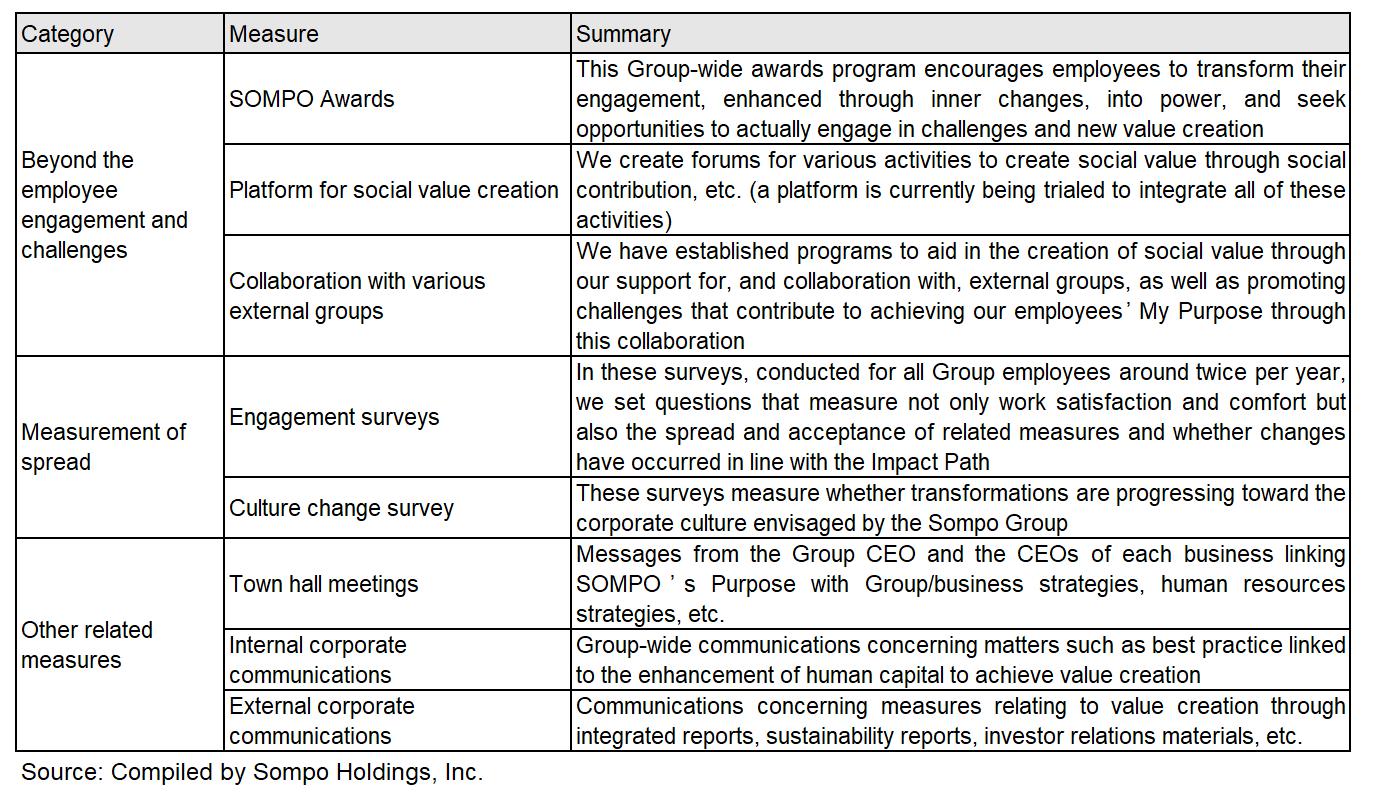
References
BSI (2022), PAS 808: “Purpose-driven organizations — Worldviews, principles and behaviours for delivering sustainability — Guide,”
https://www.bsigroup.com/en-IN/Standards-and-Publications/pas-808/ (September 26, 2024)
Business Roundtable (2019), “Business Roundtable Redefines the Purpose of a Corporation to Promote ‘An Economy That Serves All Americansʼ”
https://www.businessroundtable.org/business-roundtable-redefines-the-purpose-of-a-corporation-to-promote-an-economy-that-serves-all-americans (September 26, 2024)
European Commission, “Corporate sustainability reporting”
SEC (2023), “Draft Recommendation of the SEC Investor Advisory Committeeʼs Investor-as-Owner Subcommittee regarding Human Capital Management Disclosure”
https://www.sec.gov/files/20230914-draft-recommendation-regarding-hcm.pdf (September 26, 2024)
BSI Japan (2023) “The BSI Group (The British Standards Institution) Announces ‘PAS 808,’ the World’s First Standard Relating to Purpose-driven Organizations [Reference Materials]”
https://www.bsigroup.com/globalassets/localfiles/ja-jp/pressrelease/2023/02_-pas-808/bsipas-808.pdf?force_isolation=true (September 26, 2024)
JBpress (2023), “‘Purpose Management’ is Littered with Failures: Corporate Slaves Lose Interest and Greet Top-down Efforts with Apathy”
https://jbpress.ismedia.jp/articles/-/77500
Kato, Yohei (2016), Why is it so hard to communicate with our team members — Organizations and People Can Change! The Developmental Psychology of Transforming Yourself and Others, JMA Management Center
Kegan, Robert & Lisa Laskow Lahey (2013), Immunity to Change: How to Overcome It and Unlock the Potential in Yourself and Your Organization, trans. Chiaki Ikemura, Eiji Press
Ministry of Economy, Trade and Industry (METI) (2020), “Report of the Study Group on Improvement of Sustainable Corporate Value and Human Capital” (“ITO Report for Human Capital Management”)
https://www.meti.go.jp/policy/economy/jinteki_shihon/pdf/20200930_1e.pdf (September 26, 2024)
METI (2022a), “Ito Review 3.0 (Ito Review SX Edition) Report of the Study Group on Dialogues that Contribute to Long-term Corporate Management and Investment for Creation of Sustainable Corporate Value (SX Study Group)”
https://www.meti.go.jp/english/press/2022/pdf/0831_003a.pdf (September 26, 2024)
METI (2022b), “Results of Survey on Human Capital Management”
https://www.meti.go.jp/policy/economy/jinteki_shihon/pdf/survey_summary.pdf (September 26, 2024)
METI (2022c), “Ito Report on Human Capital Management 2.0”
https://www.meti.go.jp/policy/economy/jinteki_shihon/pdf/report2.0.pdf (September 26, 2024)
Cabinet Secretariat (2022), “Guidelines for Human Capital Visualization”
https://www.cas.go.jp/jp/houdou/pdf/20220830shiryou1.pdf (September 26, 2024)
Nawa, Takashi (2021), Purposism Beyond Capitalism: Purpose as a New Management Driver toward the Better Well-being and Harmonious Growth for the Generations to Come, Toyo Keizai Inc.
Nonaka, Ikujiro & Hirotaka Takeuchi (2020a), The Knowledge-Creating Company (New Edition), trans. Katsuhiro Umemoto, Toyo Keizai Inc.
Nonaka, Ikujiro & Hirotaka Takeuchi (2020b), The Wise Company: How Companies Create Continuous Innovation, trans. Atsushi Kurowa, Toyo Keizai Inc.
[1] The SECI Model is a knowledge creation process proposed by Ikujiro Nonaka and Hirotaka Takeuchi. This model presents a theory of how innovation is created in the process of managing knowledge (both explicit and tacit) such as expertise and information within an organization, through the interplay of knowledge in a repeated cycle of “socialization,” “externalization,” “combination,” and “internalization” (Nonaka & Takeuchi 2020a, Nonaka & Takeuchi 2020b).
[2] Adult development theory presents a systematic theory and practical method of leadership and capability development (growth), demonstrating the process of adult intellectual development that is essential for people to aim for successful transformation through repeated learning and introspection at both the individual and organizational levels (Kegan & Lahey 2013).
[3] We were assisted in analyzing data for this paper by Miho Fujisawa of Sompo Institute Plus Inc.
[4] In this analysis, we used the Welch t-test to statistically verify that there is a significant difference between the average scores for survey responses over the last two years between the two data groups (the top 25% and bottom 25% of sections and branches) at a significance level of 5%.
[5] In this simple regression analysis, we confirmed a statistically significant relationship between the variables (at a significance level of 5%). The regression coefficient refers to how much the result changes for each unit change in the factor used to predict the result: how much it “influences” the result (the result’s “sensitivity” to the factor).
